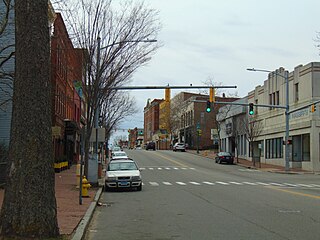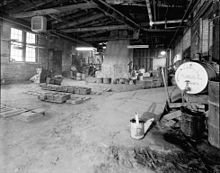
Willimantic is a census-designated place located in the town of Windham in Windham County, Connecticut, United States. It is a former city and borough. Known as "Thread City" for the American Thread Company's mills along the Willimantic River, it was a center of the textile industry in the 19th century. Originally incorporated as a city in 1893, it entered a period of decline after the Second World War, culminating in the mill's closure and the city's reabsorption into the town of Windham in the 1980s. Heroin use, present since the 1960s, became a major public health problem in the early 2000s, declining somewhat by the 2010s. Though the city was a major rail hub, an Interstate Highway has never passed within ten miles, despite early plans to connect it.

Bristol is a suburban city located in Hartford County, Connecticut, United States, 20 miles (32 km) southwest-west of Hartford. The city is also 120 miles southwest from Boston, and approximately 100 miles northeast of New York City. As of the 2010 census, the population of the city was 60,477.

Shelton is a city in Fairfield County, Connecticut, United States. The population was 39,559 at the 2010 census.

Middletown is a city located in Middlesex County, Connecticut, along the Connecticut River, in the central part of the state, 16 miles south of Hartford. In 1650, it was incorporated as a town under its original Native American name, Mattabeseck. It received its present name in 1653. Middletown was included within Hartford County upon its creation on May 10, 1666. In 1784, the central settlement was incorporated as a city distinct from the town. Both were included within newly formed Middlesex County in May 1785. In 1923, the City of Middletown was consolidated with the Town, making the city limits extensive.

Greater Hartford is a region located in the U.S. state of Connecticut, centered on the state's capital of Hartford. It represents the only combined statistical area in Connecticut defined by a city within the state, being bordered by the Greater Boston region to the northeast and New York metropolitan area to the south and west. Sitting at the southern end of the Metacomet Ridge, its geology is characterized by land of a level grade along the shores of Connecticut River Valley, with finer-grained soil than other regions in the state.

The Arrigoni Bridge, also known locally as the Portland Bridge is a steel through arch bridge carrying Route 66 and Route 17 across the Connecticut River, connecting Middletown, Connecticut to Portland, Connecticut. When it opened in 1938, the 1,200 feet (370 m) bridge was the most expensive bridge ever built in Connecticut, at a cost of $3.5 million. Its two distinctive 600 feet (180 m) steel arches have the longest span length of any bridge in the state. The bridge has an average daily traffic of 33,600.

The Air Line State Park Trail is a rail trail and linear state park located in Connecticut. The trail is divided into sections designated South, North a piece of the East Coast Greenway, and the Thompson addition. An additional 3.6 mile spur to Colchester is sometimes designated as part of the Air Line trail. At the Massachusetts state line, the trail connects to the Southern New England Trunkline Trail, a 22 mile long trail to Franklin, MA built on the same right-of-way. Since 2018, the town of Portland, CT has also maintained a 2.3 mile portion of the Airline Trail, connecting to the southern end of the state park at the town line with East Hampton.

The greater Hartford–Springfield area is an urban region and surrounding suburban areas that encompasses both north-central Connecticut and the southern Connecticut River Valley in western Massachusetts; its major city centers are Springfield, Massachusetts and Hartford, Connecticut.

A cowbell is a bell worn around the neck of free-roaming livestock so herders can keep track of an animal via the sound of the bell when the animal is grazing out of view in hilly landscapes or vast plains. Although they are typically referred to as "cow bells" due to their extensive use with cattle, the bells are used on a wide variety of animals.

The Colt Armory is a historic factory complex for the manufacture of firearms, created by Samuel Colt. It is located in Hartford, Connecticut along the Connecticut River, and as of 2008 is part of the Coltsville Historic District, named a National Historic Landmark District. It is slated to become part of Coltsville National Historical Park, now undergoing planning by the National Park Service.

O'Rourke's Diner is a diner located in the Main Street Historic District in Middletown, Connecticut.
Matt L. Lesser is an American politician who represents the 9th district in the Connecticut Senate. First elected to the State House in 2008, Lesser was re-elected in 2010, 2012, 2014, and 2016. In 2018 he was elected as state senator for the 9th district, winning 57% of the vote.

Daniel E. Carter is a politician from Connecticut. A Republican, he was elected to his first term in the Connecticut House of Representatives in November 2010, representing the state's second district in Bethel, Danbury and Redding. Following redistricting, in 2012 Newtown was added to the second district when Carter won a second term. He represented the Republican Party in the 2016 Connecticut Senate election, losing to incumbent Richard Blumenthal.

East Hampton is a town in Middlesex County, Connecticut, United States. The population was 12,959 at the 2010 census. The town center village is listed as a census-designated place (CDP). East Hampton includes the boroughs of Cobalt, Middle Haddam, and Lake Pocotopaug.

The Independent Party of Connecticut (IPC) is a minor political party in the State of Connecticut. As of November 3, 2014, Connecticut had 16,189 active voters registered with the Connecticut Secretary of State with the Independent party, making it the third largest party in the state. The party has at least one elected official. In November, 2013, Lawrence DePillo was elected to the Waterbury Board of Aldermen.

Jenean Michelle Hampton served as the 57th Lieutenant Governor of Kentucky from 2015 to 2019. Hampton was the running mate of gubernatorial candidate Matt Bevin in the 2015 election. A Republican, Hampton was the first African-American to hold statewide office in Kentucky history and the third African-American woman to have served as lieutenant governor of a U.S. state.

The first case relating to the COVID-19 pandemic in the U.S. state of Connecticut was confirmed on March 8, although there had been multiple suspected cases before that point which tested negative. As of July 20, 2020, there were 48,096 cases and 4,406 deaths in the state.
This is a List of George Floyd protests in Connecticut, United States.















